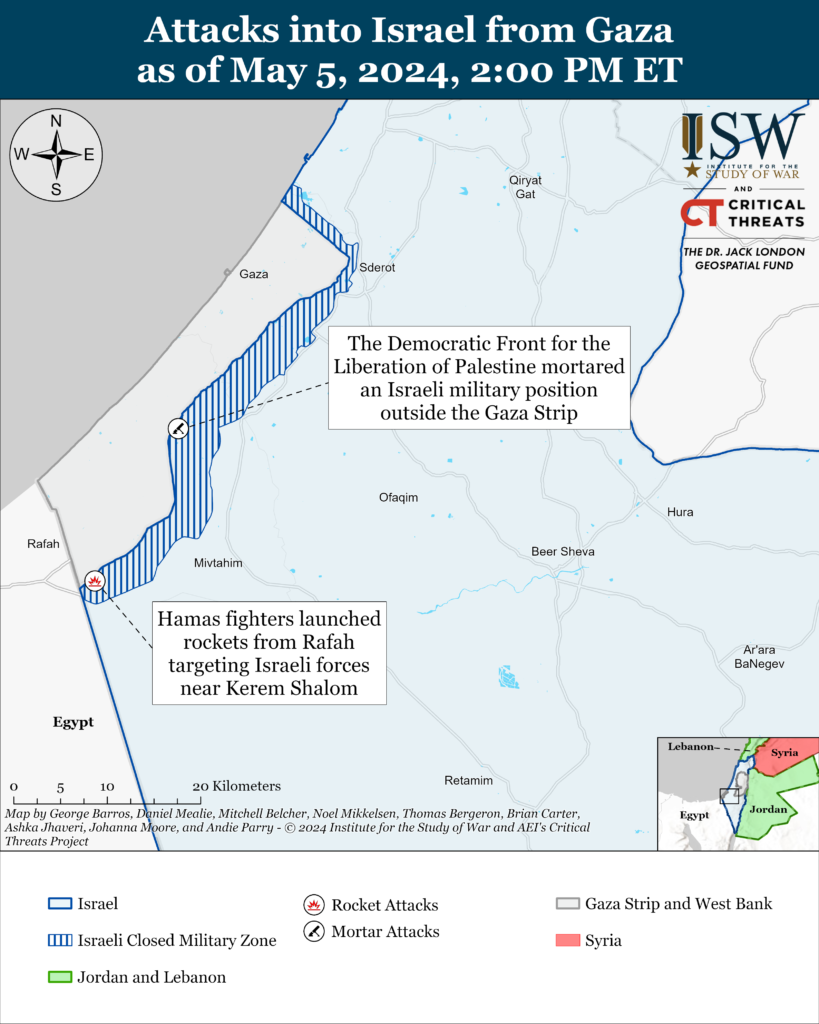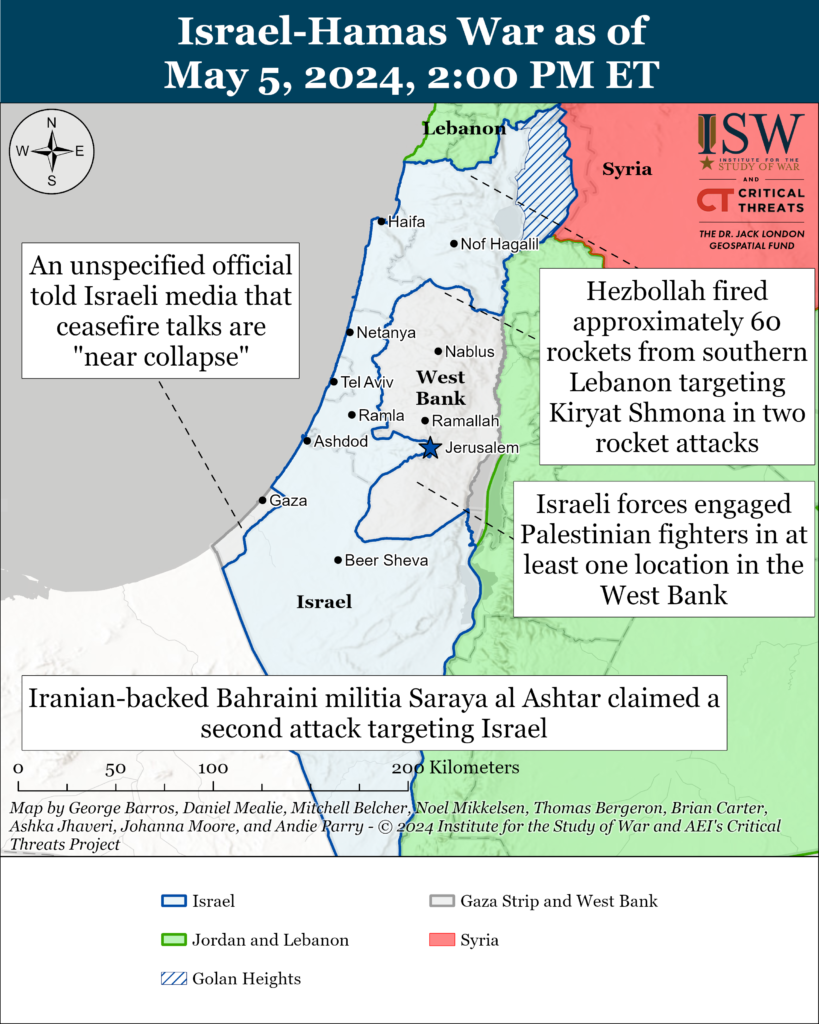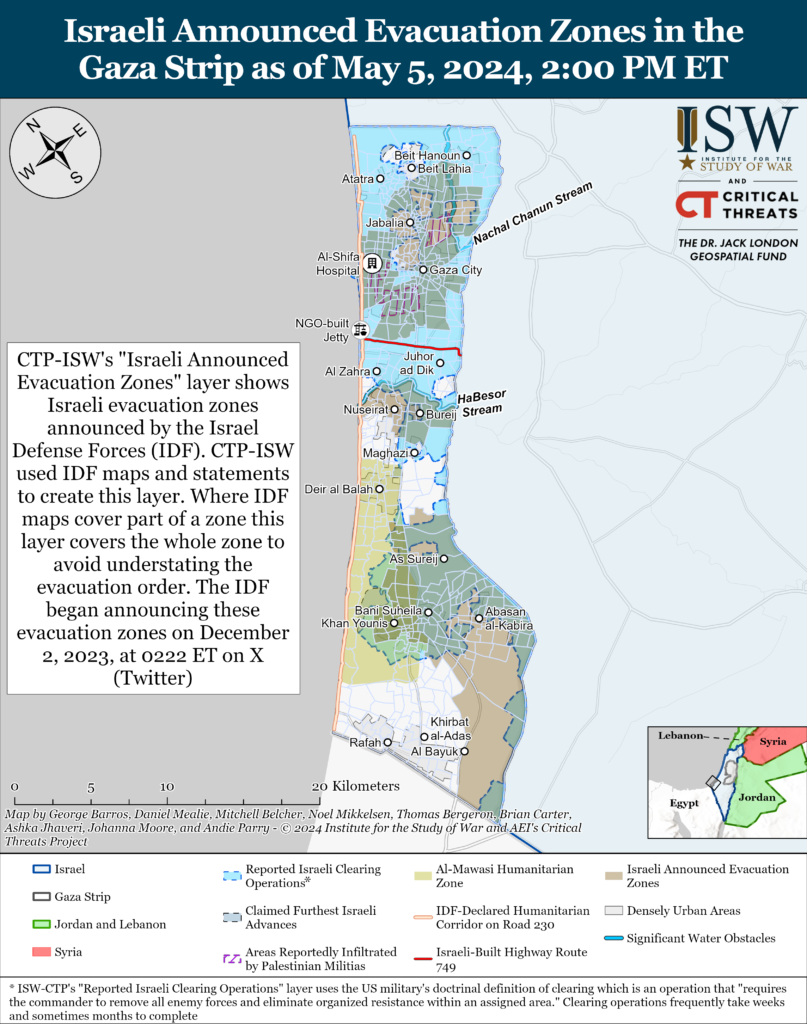The Israeli defense minister said that Israel does not believe Hamas will agree to a ceasefire. The Israeli Defense Minister Yoav Gallant told Israeli forces in the central Gaza Strip on May 5 that he anticipates ”a powerful operation in Rafah in the near future” because Israel has ”identified signs that Hamas does not intend” to agree to a ceasefire.[i] Gallant made the comment during a visit to the Netzarim Corridor.[ii] The IDF Chief of Staff Herzi Halevi visited the central Gaza Strip on May 3 to tour IDF positions and discuss IDF operations with IDF Southern Command commander Maj. Gen. Yaron Finkelman and 99th Division commander Brig. Gen. Barak Hiram.[iii] Halevi told the IDF 2nd Infantry Brigade and 679th Armored Brigades that “we have many more tasks ahead of us.”[iv]
Hamas highlighted its maximalist ceasefire demands in two official statements on May 5.[v] A Hamas negotiating delegation left Cairo to consult with Hamas leadership about the ceasefire talks on May 5.[vi] An unspecified official with knowledge of the negotiations told Israeli media on May 5 that talks are ”near collapse” after the Hamas delegation left Cairo.[vii] Hamas did acknowledge that the talks are continuing. Hamas said that it delivered its response to Egyptian and Qatari mediators and held “in-depth and serious discussions” about the response.[viii] Hamas’ May 5 statement reiterated the group’s maximalist and unchanged negotiating position, which maintains that any ceasefire needs to “completely” end the war, accomplish a complete Israeli withdrawal from the Gaza Strip, return displaced Palestinians to the northern Gaza Strip, intensify aid and reconstruction, and complete a hostage-for-prisoner swap.[ix] Hamas Political Bureau Chairman Ismail Haniyeh said on May 5 that Hamas is interested in reaching a ”comprehensive interconnected agreement” but questioned the function of an agreement ”if a ceasefire is not its first outcome.”[x]
Hamas fighters targeted Israeli forces near Kerem Shalom with indirect fire from Rafah on May 5.[xi] Hamas fired at least 10 short range 114mm rockets and mortars.[xii] A Hamas military wing source told Palestinian media that the attack targeted an IDF ”operational headquarters responsible for coordinating artillery attacks on Rafah.“[xiii] Local Israeli government officials said that the rockets struck an open area near a military position and caused injuries.[xiv] An Israeli Army Radio correspondent said that the attack injured at least 10 people.[xv] The IDF said that Hamas fired the rockets from a site about 350 meters from civilian shelters. The IDF Air Force struck the launch site shortly after the attack.[xvi] The IDF closed the Kerem Shalom crossing and inspection point in response to the rocket attack.[xvii] The Kerem Shalom crossing functions as the main entry point of humanitarian aid into the Gaza Strip. It remains unclear how long the IDF will keep the crossing closed.

Recorded reports of attacks; CTP-ISW cannot independently verify impact.
Key Takeaways:
- Gaza Strip: A Hamas rocket attack forced the IDF to pause operations at a key aid inspection site in southern Israel.
- Ceasefire Negotiations: The Israeli defense minister said that Israel does not believe Hamas will agree to a ceasefire. Hamas highlighted its maximalist ceasefire demands in two official statements on May 5.
- West Bank: Israeli forces engaged Palestinian fighters in at least one location in the West Bank on May 4 after CTP-ISW’s last data cut off.
- Lebanon: Iranian-backed fighters, including Lebanese Hezbollah, have conducted at least 11 attacks from southern Lebanon into northern Israel since CTP-ISW’s last data cutoff on May 4.

Gaza Strip
Axis of Resistance objectives:
Erode the will of the Israeli political establishment and public to sustain clearing operations in the Gaza Strip
Reestablish Hamas as the governing authority in the Gaza Strip
Three Palestinian militias conducted at least five attacks targeting Israeli forces near the Netzarim corridor on May 5. Most Palestinian militias targeted Israeli personnel with indirect fire.[xviii] A Hamas sniper targeted Israeli personnel north of the Netzarim Corridor, however.[xix] Israeli forces have established forward operating bases along the Netzarim Corridor to facilitate future raids into the northern and central Gaza Strip.[xx] Palestinian militias have claimed almost daily indirect fire attacks targeting Israeli forces near the Netzarim corridor since April 18.[xxi]
The Israel Defense Forces (IDF) killed several Hamas and Palestinian Islamic Jihad (PIJ) commanders in strikes across the Gaza Strip on May 4 and 5. The IDF Air Force killed a PIJ commander in Rafah on May 4 who commanded a PIJ special operations forces unit on October 7. The commander was responsible for preparing a strategy for PIJ fighters in the southern Gaza Strip.[xxii] The IDF said that the PIJ commander had ”personally led several incursion attempts into Israeli territory.”[xxiii] The IDF Air Force coordinated with ground forces to conduct airstrikes killing three Hamas Nukhba force fighters on May 5.[xxiv] The IDF also killed the Hamas Bureij Battalion combat support unit commander in the central Gaza Strip on May 5.[xxv] The IDF Air Force also killed a Hamas deputy company commander in Jabalia and two other Hamas fighters.[xxvi] The IDF said that some of the killed Palestinian fighters killed participated in the October 7 attacks.[xxvii]
Israeli forces struck Palestinian fighters and militia infrastructure across the Gaza Strip on May 5. The IDF 143rd Division fired artillery at a Hamas rocket launch position that contained launchers that Palestinian fighters had prepared to fire into southern Israel.[xxviii] The IDF Air Force targeted several Palestinian fighters, including two fighters near a rocket launch site and a sniper who posed a threat to Israeli forces. [xxix]
The IDF 2nd Infantry Brigade and 679th Armored Brigade have continued to operate in the central Gaza Strip.[xxx] The brigades killed Palestinian fighters and destroyed militias infrastructure on May 5.[xxxi]


West Bank
Axis of Resistance objectives:
Establish the West Bank as a viable front against Israel
Israeli forces engaged Palestinian fighters in at least one location in the West Bank on May 4 after CTP-ISW’s last data cut off.[xxxii] Al Aqsa Martyrs’ Brigades fighters targeted Israeli forces in Nablus with ”machine gun” fire and improvised explosive devices (IED).[xxxiii]
The IDF released additional details on Israeli forces’ raid in Deir al Ghusoun on April 3. The IDF reported that the Palestinian fighters were part of a Hamas cell in Tulkarm that had carried out numerous shooting, bombings, and car bomb attacks.[xxxiv] Israeli forces killed three Hamas fighters and one PIJ fighter during the operation.[xxxv] Three of the four fighters had previously been imprisoned for “military” and “Hamas activities.”[xxxvi] Israeli forces arrested a fifth fighter.[xxxvii]

This map is not an exhaustive depiction of clashes and demonstrations in the West Bank.
Southern Lebanon and Golan Heights
Axis of Resistance objectives:
Deter Israel from conducting a ground operation into Lebanon
Prepare for an expanded and protracted conflict with Israel in the near term
Expel the United States from Syria
Iranian-backed fighters, including Lebanese Hezbollah, have conducted at least 11 attacks from southern Lebanon into northern Israel since CTP-ISW’s last data cutoff on May 4.[xxxviii] Lebanese Hezbollah fired approximately 60 rockets from southern Lebanon targeting Kiryat Shmona in two rocket attacks on May 5.[xxxix] The IDF reported that approximately 40 rockets were fired in one salvo according to an Israeli war correspondent.[xl] Israeli Army Radio reported that the attack damaged multiple buildings in Kiryat Shmona.[xli] Hezbollah also fired ”dozens” of Katyusha rockets targeting Israeli forces and artillery located at al Zaoura, Golan Heights.[xlii] Hezbollah said these rocket attacks were retaliation for an Israeli strike in Mays al Jabal. Hezbollah said that the Israeli strike in Mays al Jabal killed and wounded civilians.[xliii]

Recorded reports of attacks; CTP-ISW cannot independently verify impact.
Iran and Axis of Resistance
The Islamic Resistance in Iraq—a coalition of Iranian-backed Iraqi militias—claimed that it conducted a long-range missile attack targeting the Haifa Port on May 4.[xliv] The Islamic Resistance in Iraq claimed that it used “Arqab” cruise missiles in the attack. Israeli officials and media have not commented on the attack at the time of this writing. The Islamic Resistance in Iraq recently claimed two “Arqab” cruise missile attacks targeting Israel on May 2.[xlv] The group also claimed two “Arqab” cruise missile attacks targeting Israel in January 2024.[xlvi]
Saraya al Ashtar—an Iranian-backed Bahraini militia—claimed on May 4 that it conducted a drone attack targeting an unspecified “vital target” in Eilat, Israel, on May 2.[xlvii] It is unclear whether Saraya al Ashtar launched its attack from within Bahrain. This attack marks the second time Saraya al Ashtar has claimed an attack targeting Israel since the Israel-Hamas war began. Saraya al Ashtar claimed on May 2 that it conducted a drone attack targeting Eilat on April 27.[xlviii] Saraya al Ashtar’s first attack specifically targeted the Israeli transportation company Trucknet Enterprise, suggesting that the attack was part of the Iranian-led campaign to impose an unofficial blockade on Israel.[xlix]
 Eurasia Press & News
Eurasia Press & News




